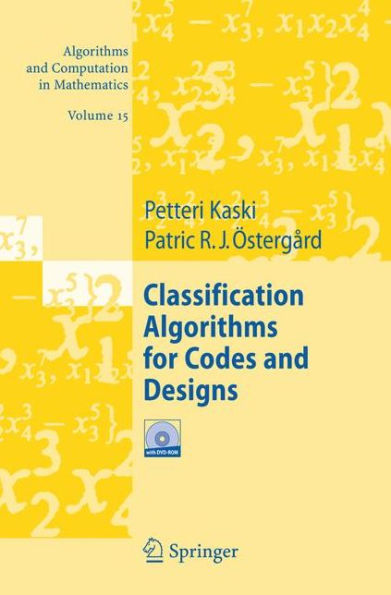Classification Algorithms for Codes and Designs
A new starting-point and a new method are requisite, to insure a complete [classification of the Steiner triple systems of order 15]. This method was furnished, and its tedious and difficult execution und- taken, by Mr. Cole. F. N. Cole, L. D. Cummings, and H. S. White (1917) [129] The history of classifying combinatorial objects is as old as the history of the objects themselves. In the mid-19th century, Kirkman, Steiner, and others became the fathers of modern combinatorics, and their work – on various objects, including (what became later known as) Steiner triple systems – led to several classification results. Almost a century earlier, in 1782, Euler [180] published some results on classifying small Latin squares, but for the first few steps in this direction one should actually go at least as far back as ancient Greece and the proof that there are exactly five Platonic solids. One of the most remarkable achievements in the early, pre-computer era is the classification of the Steiner triple systems of order 15, quoted above. An onerous task that, today, no sensible person would attempt by hand calcu- tion. Because, with the exception of occasional parameters for which com- natorial arguments are effective (often to prove nonexistence or uniqueness), classification in general is about algorithms and computation.
1101518996
Classification Algorithms for Codes and Designs
A new starting-point and a new method are requisite, to insure a complete [classification of the Steiner triple systems of order 15]. This method was furnished, and its tedious and difficult execution und- taken, by Mr. Cole. F. N. Cole, L. D. Cummings, and H. S. White (1917) [129] The history of classifying combinatorial objects is as old as the history of the objects themselves. In the mid-19th century, Kirkman, Steiner, and others became the fathers of modern combinatorics, and their work – on various objects, including (what became later known as) Steiner triple systems – led to several classification results. Almost a century earlier, in 1782, Euler [180] published some results on classifying small Latin squares, but for the first few steps in this direction one should actually go at least as far back as ancient Greece and the proof that there are exactly five Platonic solids. One of the most remarkable achievements in the early, pre-computer era is the classification of the Steiner triple systems of order 15, quoted above. An onerous task that, today, no sensible person would attempt by hand calcu- tion. Because, with the exception of occasional parameters for which com- natorial arguments are effective (often to prove nonexistence or uniqueness), classification in general is about algorithms and computation.
129.99
In Stock
5
1

Classification Algorithms for Codes and Designs
412
Classification Algorithms for Codes and Designs
412Hardcover(2006)
$129.99
129.99
In Stock

Product Details
| ISBN-13: | 9783540289906 |
|---|---|
| Publisher: | Springer Berlin Heidelberg |
| Publication date: | 12/22/2005 |
| Series: | Algorithms and Computation in Mathematics , #15 |
| Edition description: | 2006 |
| Pages: | 412 |
| Product dimensions: | 6.10(w) x 9.25(h) x 0.24(d) |
From the B&N Reads Blog
